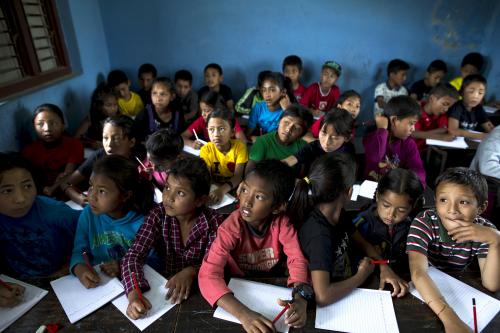Introduction
Reaching education goals in the coming years will require sharp increases in funding and better delivery. Despite a global focus on improving access to education, nearly 60 million children in developing countries remain out of primary school and increased investments have not translated to better education quality or improved learning outcomes (UNESCO 2015a). Even with an increase in domestic public expenditure, UNESCO estimates that the financing gap for delivering good quality universal education from pre-school through junior secondary levels by 2030 in low-income countries will be $10.6 billion, on average, between 2015 and 2030—over four times the level currently provided by official donors ($2.3 billion) (UNESCO 2015b).
Closing acute financing and delivery gaps that prevent access to quality education will be a major challenge, requiring all hands on deck. Domestic governments and foreign donors will need to step up their game substantially, but fiscal and capacity constraints are likely to prevent them remedying resource deficits on their own in the short term. Non-state actors—mainly religious and charitable organizations, private (“foundation”) schools, and a small number of for-profit schools—are already partially filling the gaps, although the precise extent of their services and their impact is unknown.
Determining the appropriate role of non-state actors in education is a contentious topic among specialists. Disagreements have revolved around serious normative issues, including such basic questions as whether non-state provision is consistent with the principle of education as a human right, and serious empirical questions relating to quality and equity implications. This discussion has been blurred by definitional issues (i.e., what is non-state and private education?); lack of clarity over distinctions between ownership, delivery, and financing; a lack of accurate data on current and potential provision rates; and an insufficient base of evidence from which to draw clear conclusions on the effectiveness of non-state engagement in education. These problems have made it difficult to generate comparisons across empirical studies, leading to significant variation in the interpretation of evidence. For some observers, evidence has fueled concern that non-state education is violating human rights principles (e.g., the report by the United Nations Rapporteur on Education),1 while for others it has provided encouragement that non-state engagement can help address financing and delivery challenges (e.g., Tooley 2009).
Our goal is to provide a neutral background to this debate and identify areas of common ground. Beginning with some big picture facts, this paper develops a detailed language around non-state actors in education. We then outline current issues and poles of debate around engagement of non-state actors in education and provide an assessment of the depth of available data and evidence. To close, we establish a typology and propose a framework for discussions around the role of non-state actors in basic education and how these actors can best contribute to the achievement of Education for All and the Sustainable Development Goals (SDGs). Our paper refers largely to basic education, including pre-primary, primary, and lower-secondary, as this is the main focus of much recent discussion around the role of non-state actors in education and an area of strong growth in developing countries.
The Brookings Institution is committed to quality, independence, and impact.
We are supported by a diverse array of funders. In line with our values and policies, each Brookings publication represents the sole views of its author(s).












